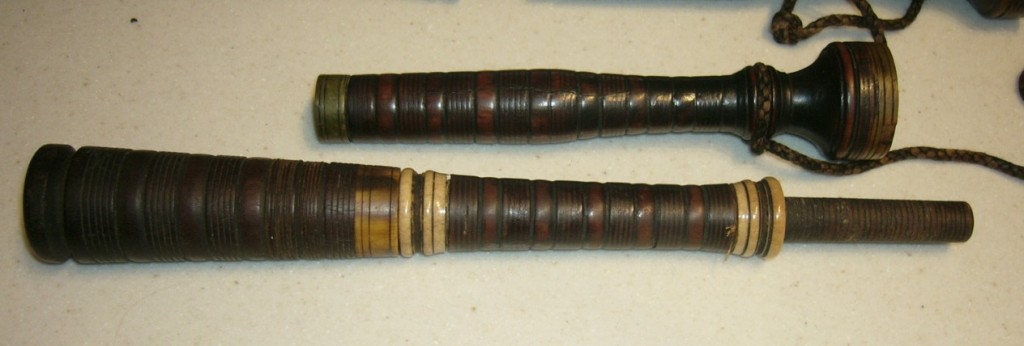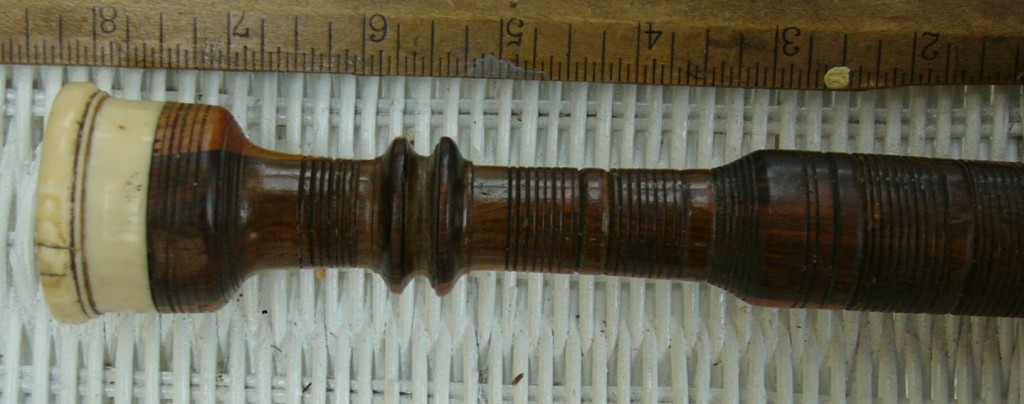2011, no publisher identified
Since I have owned a copy of Jeannie Campbell’s first edition of Highland bagpipe Makers for ten years I looked upon receipt of her enlarged second edition with a certain amount of excitement. It has proved to be a great resource for me over the past decade and during my research I have referred to it on several occasions. As someone who is very interested in pipe making in my own region of Atlantic Canada I immediately opened the book and looked up the two, of a half dozen or so pipe makers in Nova Scotia, who made the final cut in Jeannie’s recent offering : Duncan Gillis and Robert Ross, but more on them later.
Jeannie’s new book is overflowing with information, price lists, photographs of prominent pipers and one can’t help but be impressed by the sheer number of manufacturers who plied their skill over the past two and half centuries, especially during the “Golden Age” of bagpipe making which as Jeannie points out straddled the late 19th and early 20th centuries. It contains a small section on pipe making in general and photographs of the turning process for pipe manufacture. It also lists materials used in the manufacture of bagpipes such as the various types of wood and mounting and includes information on reeds and modern innovations. The number of pipe makers has increased from 108 in her previous edition to over 124 in the revised edition. The revised text includes stories and anecdotes about individual bagpipe makers and the professional pipers who often aligned themselves as consultants and shop managers to the better known firms such as Lawrie and Henderson.
Jeannie’s recent offering represents years of painstaking research into the lives and family histories of dozens of bagpipe makers, some famous – others virtually unknown. She sifted through Parish Records, Census documents, and obscure articles and books for her research (although there is no bibliography and no footnotes). The quality of the photographs have improved somewhat from the first edition but if pipers are looking for a collection of photographs of instruments which will help them identify vintage bagpipes then this book will be of minimum assistance. A useful addition to the text, although probably financially prohibitive, might have been a CD containing close-up photographs of the bagpipes illustrated in the book.
For the uninitiated some of the genealogical material contained in the book is pretty dry reading at times. It does however illustrate just how some families in Victorian Britain, especially children at very early age, were required to contribute to the overall household income. For instance Gavin C MacDougall, age 16, is listed as a bagpipe maker in the 1891 census, indicating a very early apprenticeship and in the case of George S MacKay, his older sisters aged 16 and 15 were employed as steam loom weavers while his older brother, age 12, was a tailor after his father’s death. What is missing from the book is why so many pipe making firms went out of business. Many pipe makers came and went and I suspect gaining military contracts, and later overseas contracts, might have been one of the main avenues to a successful pipe making firm and the limited nature of these contracts maybe why so few survived. Another reason for the discontinuation of some firms may have been a quality issue: samples of Henderson, Glen and Lawrie bagpipes seem to be quite common nowadays while examples of many of the smaller makers are quite rare.
In a book of this size it should also be pointed out that it is not free of errors. The list of present day bagpipe makers which appears on page 260 identifies the United States bagpipe making firms of C E Kron, Roderick Maclellan, Gibson, and Cushing as all being located in Canada, and the one current maker of bagpipes in Nova Scotia, John Walsh, not mentioned at all. This was obviously an editing oversight since it was already pointed out in a previous review of her first edition.
I must say I was a bit disappointed in the material presented on Nova Scotia bagpipe makers Duncan Gillis and Robert Ross. I wrongly assumed the information on these two local pipe makers would have been updated, and that she would not use research which was already 15 years old. A better source for material (and more current) on both Gillis and Ross would have been my recently published article entitled “Wood, Horn and Bone: A Survey of Immigrant Bagpipes and Regional Pipe-making in Nova Scotia, 1820-1920” which was published in Josh Dickson’s The Highland Bagpipe: Music, History and Tradition. (Surrey, England : Ashgate Publishing, 2009) and a more detailed description of pipe makers in Nova Scotia and the materials they used can be found in Dance to the Piper: The Highland Bagpipe in Nova Scotia (Sydney: Cape Breton University Press, 2008)
The photograph of a bagpipe on page 117 is indeed that of a Gillis instrument and I identified it as such on visit to Glasgow back in 1999. At the time Jeannie was nice enough to take me on a tour of the College of Piping museum and Duncan’s pipes immediately stood out for me since I had acquired an almost complete identical set a few years earlier (Fig. 1).
The set in the College Museum had previously been attributed to an unknown late 19th century Scottish maker. The style is very different from a sample of Robert Ross’ work which surfaced in Nova Scotia a few years ago (Fig. 2).
The story of just how Seumas MacNeill acquired the instrument now in the College of Piping Museum is not quite correct either and it is unfortunate Jeannie did not check her sources for accuracy before publishing the information. Much of what appears in her biographical information of Duncan Gillis was taken from a third party article that was based on one I wrote back in the late 1990s for the local Celtic journal Am Braigh. The third party article contained several errors and omissions largely due to editorial re-writes and these were subsequently republished by Jeannie.
In reality Seumas MacNeill bought the instrument for 12 dollars from Allan C. MacDonald, a First World War veteran piper who was originally from East Bay. The bagpipe pictured in Jeannie’s book was initially offered for sale to Danny MacIntyre, a local piping instructor at the Gaelic College, but Danny didn’t have his wallet with him at the time. Danny returned to his car to retrieve his wallet but by the time he had returned Seumas had persuaded Allan C. to sell him the bagpipe instead. Danny MacIntyre was the Pipe Major of the first band I played with and he often told the story of the bagpipe purchase.
A surprise in the book for me was the images of the bagpipe attributed to J. MacDougall of Dundee (page 27). I had an opportunity to examine, appraise and photograph this instrument several years ago in Halifax (Fig. 3).
Fig 3. J. MacDougall Bagpipe, Pictou County, Nova Scotia (©Barry Shears)
This bagpipe was an immigrant set brought to Pictou County, Nova Scotia, and unfortunately it was sold and resold to collectors outside the Province without any attempt to catalogue its history and provenance or to offer it to a local museum for display. This seems to be happening with more frequency nowadays as was the case recently with Iain Dall MacKay’s pipe chanter.
But these are all minor points considering the impressive number of bagpipe makers listed in the book. Everything considered, I am still excited to have my copy of the second edition. Jeannie Campbell’s Highland Bagpipe Makers is excellent value for money and a long overdue resource for pipers. It adds immeasurably to an ever increasing body of scholarship dealing with bagpipes and bagpipe history. It should hold a special place in any serious piper’s library and illustrate to a great many pipers why it is so hard for the handful of experts out there to accurately identify older instruments without a maker’s mark or a sales slip.


